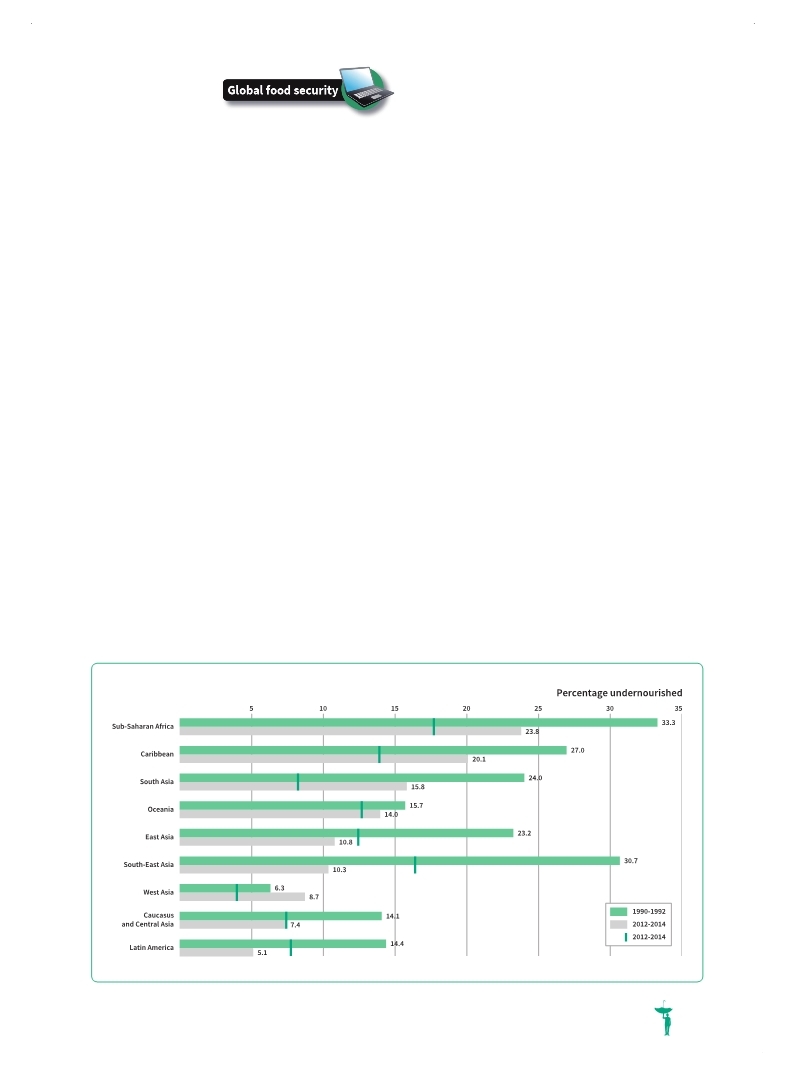 |
Global Assessment Report on Disaster Risk Reduction 2015
Making development sustainable: The future of disaster risk management |
 |
Global Assessment Report on Disaster Risk Reduction 2015
Making development sustainable: The future of disaster risk management |
|
|

191
Food security
Food security has improved in recent decades. Since 1990, the global rate of undernourishment has fallen from 18.7 to 11.3 per cent (FAO et al., 2014) and 52 countries have managed to reach the hunger target of the Millennium Development Goals. However, current estimates indicate that more than 800 million people around the world are still chronically undernourished (ibid.), and there are marked differences in progress across regions. Sub-Saharan Africa still has higher rates of undernourishment than other regions, while the situation in West Asia has actually deteriorated (Figure 9.6).
This mixture of progress on the one hand and persistent challenges on the other shows that sustained political commitment, together with major investments in risk-sensitive food production and consumption, will be required if global and sustainable food security is to be achieved (UNISDR, 2013a
UNISDR. 2013a,Global Assessment Report on Disaster Risk Reduction: From Shared Risk to Shared Value: the Business Case for Disaster Risk Reduction, Geneva, Switzerland: UNISDR.. . and climate change, the challenges are likely to increase in the future.
Social protection
Social protection has received significant support from international aid budgets. For example, the World Bank alone allocated an average annual budget of US$1.72 billion for social protection between 2007 and 2013 and approved 273 projects in 93 countries with a total value of US$12 billion over the same period.
There are examples of successful initiatives in prospective disaster risk management that have effectively reduced vulnerability by combining disaster risk management with poverty reduction (UNISDR, 2011a
UNISDR. 2011a,Global Assessment Report on Disaster Risk Reduction: Revealing Risk, Redefining Development, Geneva, Switzerland: UNISDR.. . Arnold, Margaret, Robin Mearns, Kaori Oshima and Vivek Prasad. 2014,Climate and Disaster Resilience: The Role for Community-Driven Development, Social Development Department. The World Bank and GFDRR. Washington, D.C.. .  GFDRR, 2014d GFDRR, 2014d GFDRR (Global Facility for Disaster Reduction and Recovery). 2014d,Building Social Resilience of the Poor: Protecting and Empowering Those Most at Risk, Background Paper prepared for the 2015 Global Assessment Report on Disaster Risk Reduction. Geneva, Switzerland: UNISDR.. GFDRR (Global Facility for Disaster Reduction and Recovery). 2014d,Building Social Resilience of the Poor: Protecting and Empowering Those Most at Risk, Background Paper prepared for the 2015 Global Assessment Report on Disaster Risk Reduction. Geneva, Switzerland: UNISDR.. Click here to view this GAR paper. Figure 9.6 Trends in undernourishment: regional differences
(Source: FAO et al., 2014.)
|
 
Page 1Page 10Page 20Page 30Page 40Page 50Page 60Page 70Page 80Page 90Page 100Page 110Page 120Page 130Page 140Page 150Page 160Page 170Page 180Page 181Page 182Page 183Page 184Page 185Page 186Page 187Page 188Page 189Page 190Page 191Page 192->Page 193Page 194Page 195Page 196Page 197Page 198Page 199Page 200Page 201Page 202Page 203Page 204Page 205Page 210Page 220Page 230Page 240Page 250Page 260Page 270Page 280Page 290Page 300Page 310
|
|
 
|
 
|
